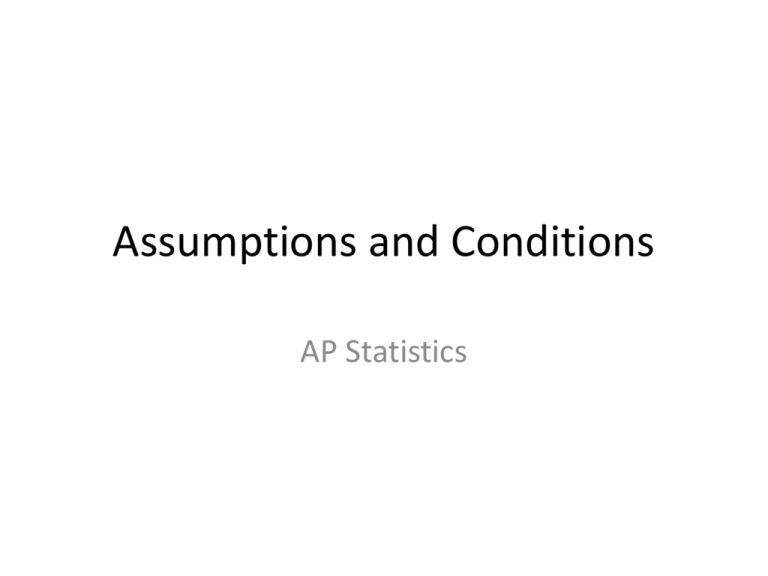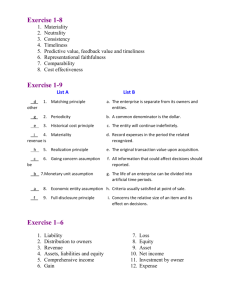Assumptions and Conditions
advertisement

Assumptions and Conditions AP Statistics Assumptions • Many statistical methods (ex. confidence intervals, one-proportion z-tests, Bernoulli trials) are based on important assumptions. • Those methods cannot be applied or used unless those conditions are met. • How do we know if those assumptions are met? They can be difficult or impossible to satisfy in certain situations. Assumptions Generally, there are three types of Assumptions: 1. Unverifiable: We must simply accept these as reasonable—after careful thought. 2. Plausible, based on evidence: We test a condition to see if it is reasonable to believe that the Assumption is true. 3. False, but close enough: We know the Assumption is not true, but some procedures can provide very reliable results even when an Assumption is not fully met. In such cases, a condition may offer a rule of thumb that indicates whether or not we can safely override the Assumption and apply the procedure anyway. Assumptions and Conditions • A condition, therefore, is a testable criterion that supports or overrides an assumption. • It is used in types 2 and 3 on previous slide. Collection 1 temp <new> 1 6 2 9 3 10 4 8 5 12 6 9 7 9 8 11 9 9 10 8 11 7 12 10 13 10 14 10 15 6 16 9 17 9 18 12 19 11 20 8 21 8 22 9 23 8 24 13 25 9 26 9 Example The daily temperatures in Philadelphia for February are shown to the left. Is a temperature of 6 degrees considered unusual? Collection 1 temp <new> 1 6 2 9 3 10 4 8 5 12 6 9 7 9 8 11 9 9 10 8 11 7 12 10 13 10 14 10 15 6 16 9 17 9 18 12 19 11 20 8 21 8 22 9 23 8 24 13 25 9 26 9 Example The daily temperatures in Philadelphia for February are shown to the left. Is a temperature of 6 degrees considered unusual? If you were planning to use the Normal curve and find the z-score, etc. then you are working under the NORMAL DISTRIBUTION ASSUMPTION. In other words, you are assuming that the population is Normally distributed. Is it? Collection 1 temp <new> 1 6 2 9 3 10 4 8 5 12 6 9 7 9 8 11 9 9 10 8 11 7 12 10 13 10 14 10 15 6 16 9 17 9 18 12 19 11 20 8 21 8 22 9 23 8 24 13 25 9 26 9 Example The daily temperatures in Philadelphia for February are shown to the left. Is a temperature of 6 degrees considered unusual? To see if the population is Normally distributed (Normal Distribution Assumption), you must satisfy the NEARLY NORMAL CONDITION—which states that the data are roughly unimodal and symmetric. This can be done by showing a histogram, normal probability plot, etc. Example—Answer (Satisfying of Condition) “In order to answer this question, a Normal Model will be used. The use of the Normal model, however, requires the Assumption of a Normal Distribution for the population. Since the distribution of the population is unknown, we must, instead, attempt to justify the Nearly Normal Condition. The distribution of daily temperatures in Philadelphia during February is shown below. As can be seen, the distribution is roughly symmetric and unimodalthus satisfying the Nearly Normal Condition and allowing us to use the Normal curve to model this data.” Assumptions and Conditions for Inference for a Proportion Independent Trials Assumption: Sometimes we will simply accept this—flipping a coin, taking foul shots, etc. However, if we are trying to make inferences about a population proportion based on a sample drawn without replacement, then this assumption is clearly false. However, we can proceed if we satsify: Random Condition 10% Condition Assumptions and Conditions for Inference for a Proportion Normal Distribution Assumption Very good chance that this is false—that the population from which the sample is drawn from is normal. However, that does not matter if we can satisfy: Success/Failure Condition This can confirm that the sample is large enough to make the sampling model close to Normal Assumptions and Conditions for “Proportions” The assumptions and conditions needed for Inference for a Proportion are the same ones used for the following “Proportion” methods: Sampling Distribution Model for a Proportion creating a sampling model from a population Creating Confidence Intervals for Proportions




